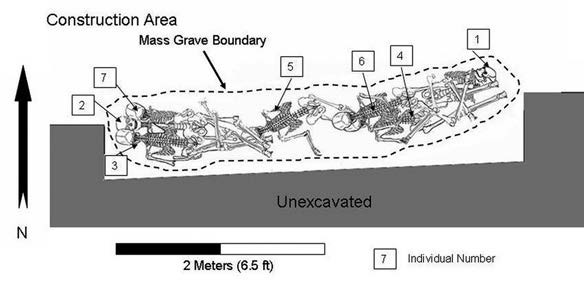Dublin Core
Title
Description
A mass grave was found in Nephi, Utah, proving how archaeology can provide a voice for the dead.
In 2006, while digging the foundation for a new house in the central Utah town of Nephi, construction workers uncovered human bones. In fact, seven Native American skeletons were discovered piled in what could only be described as a mass grave. Who were these people?
State Archaeologists were called in to map the site and carefully excavate the remains. Gunshot wounds were found in the skulls of several of the skeletons, and one – the skeleton of a young boy – showed a gunshot wound through his upper leg. Analysis of the remains revealed they were all males, ranging in age from 10 to 35, and all in good health until their deaths. So what happened to them?
Historical records from 1853 shed some light on this mystery. That summer, the so-called Walker War erupted and hostilities between Mormons and Utah’s Native people intensified into a series of tit-for-tat killings. Ute leader Wakara directed raids on Mormon settlements in retaliation for their encroachment on Native lands, and the settlers responded in kind.
On October 2, 1853, a group of Utes – or possibly Goshutes – came to the fort at Nephi. The official record states that town leaders wanted to question them about the recent deaths of four men from Manti, but that the “Indians showed fight” and that a “skirmish ensued.” By the end of the day, seven Native Americans were dead and their bodies thrown into a mass grave.
But forensic evidence reveals that these men did not die in any “skirmish” but were instead coldly executed. The trajectories of the gunshot wounds indicate they were shot in the back of the head, possibly while on their knees. Personal diary entries written by two women who witnessed the event confirm the forensic analysis.
This incident of the Walker War – and the grave’s discovery 153 years later – shows how the historic record can be contradicted by scientific evidence, and how archaeology can allow victims to tell their story.
Creator
Source
_______________
See Ronald J. Rood, Archaeological Excavation of 42JB1470, and Derinna Kopp, Forensic Report for 42JB1470, reports on file at Utah Division of State History, Archaeology/Antiquities Section, Salt Lake City, UT, 2006; Ronald J. Rood and Derinna Kopp (with contributions by Robert Carter), “They Were Killed on a Sunday Morning, October 2nd, 1853: the Archaeology of a Mass Grave and one Event of the Walker War, Utah Territory,”; “Native American Remains Reveal Evidence of Being Executed,” The Nephi Times-News, 2006, accessed http://www.nephitimesnews.com/0607/062707/4.htm and http://www.nephitimesnews.com/0806/080906/3.htm; Tina Kelley and Kathryn L. MacKay, “Wakara,” Utah History Encyclopedia; Thomas G. Alexander, “The Walker War,” Utah, The Right Place

